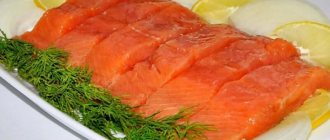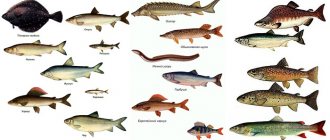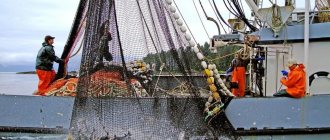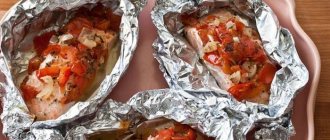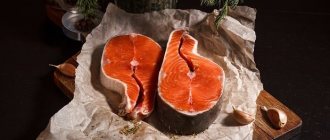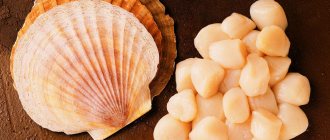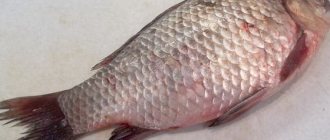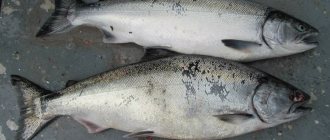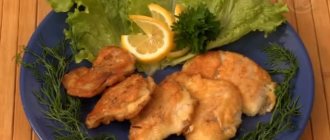Biological characteristics and varieties
Among Pacific salmon, one of the most common fish species is chum salmon. This large fish can reach a length of 1 m and a weight of 15 kg. Life time is limited to seven years. During this time, chum salmon must go through two periods. 1. First, at a young age, the fish gains weight in sea waters away from the coast. Before the onset of sexual maturity, this representative of salmon has a shiny silver color. The body of chum salmon has an elongated massive shape. The fish meat is bright red in color and has a dense structure. 2. Appearance changes greatly before the mating season. Chum salmon become aggressive, gathering in large schools. Migration begins to the rivers where spawning will take place. During this period, a physiological transformation occurs, affecting the appearance. Marital changes occur in the shape of the body, it increases in width. The fish's head takes on a menacing appearance, both jaws bend, and large teeth appear on them. As they approach spawning, the body color changes greatly. First, a yellow-brown color appears with purple spots on the sides. And before spawning, the fish turns black, while the meat turns white, losing taste and value. Ichthyologists distinguish two varieties of chum salmon. 1. In the northern regions there is a summer population. It grows up to 80 cm in length, reaching a weight of 8 kg. 2. The autumn variety prefers to live in southern latitudes. Its size is limited to 1 m, and its weight is 14 kg.
What does chum salmon look like?
Pacific salmon of the species Oncorhynchus keta live in sea water all their lives, therefore they have a classic silver-azure color with a tint, darker in the ridge area and lighter on the belly. This color scheme is optimal for pelagic fish in the middle transparent layers, making them equally invisible both against the background of a well-lit water surface and on the gray-lead bottom.
Other features of the appearance of chum salmon include:
- massive, elongated body;
- compressed sides;
- dorsal (9-11 rays) and adipose fins shifted towards the tail;
- large conical head;
- wide, semi-lower mouth with underdeveloped teeth;
- absence of dark spots and stripes;
- medium scales (130-150 pieces in the lateral line);
- large caudal fin without notch.
During spawning, the appearance of chum salmon changes dramatically - the body becomes taller and wider, and a hump is formed. The jaws lengthen and bend, and large teeth appear on them. The silver color gives way to yellow-brown, olive and greenish tones. Large crimson or purple transverse stripe spots clearly appear on the sides, which gradually darken.
Habitat
For a targeted hunt for valuable fish from the salmon family, you should know where chum salmon are found. This inhabitant of the marine ichthyofauna is an anadromous species. The fish is widespread in the waters of the Pacific Ocean. Flocks of sexually mature individuals go to the rivers of North America, Asia and the Far East to spawn. Salmon fatten in the northern Pacific waters near the front of the warm Kuro-Sivo current. The fish is found in the Bering, Okhotsk and Japan seas. During fattening, schools of chum salmon occupy the upper horizons, plunging down to 10 m. In spring, chum salmon move to the mouths of rivers that flow through Japan, South Korea, the Far East, Canada and the USA. A massive movement is observed in the rivers of the Sea of Okhotsk. A lot of fish enter Siberian rivers such as the Kolyma, Lena, Indigirka and Yana. This is interesting! Having reached the river mouths, schools of chum salmon split into two herds. Sexually mature individuals make their final journey upstream, and young fish migrate south.
What is chum salmon of the summer and autumn races?
Ichthyologists distinguish two main seasonal forms of Oncorhynchus keta, differing in timing of spawning, fertility, growth rate and size. The leading role is occupied by the autumn race, which goes to rivers to spawn in September - November with still underdeveloped reproductive products. The duration of the journey upstream can take 2-4 weeks (up to 2 thousand km). This time is enough for the eggs and milt to fully mature. The maximum size of autumn chum salmon reaches 100-110 cm with a weight of 18-19 kg and is a record for the entire genus. But most often in catches there are specimens 60-70 cm with a mass of 3-5 kg.
To learn more:
Salmon is a red fish from the salmon family.
The period of reproduction of the summer race falls from the end of June to September. The fish has already formed reproductive products, so it does not go on a long journey upstream, but spawns near the mouth. The largest weight of summer chum salmon is 6-7 kg. Commercial catches are dominated by individuals with a body length of 50-60 cm (2.5-3 kg).
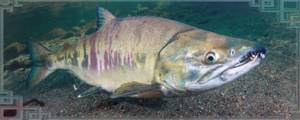
Nutrition
The diet of chum salmon most often contains food items such as small mollusks, crustaceans, as well as small representatives of herring and smelt. When the fish goes to spawning grounds, it does not feed, and its digestive organs atrophy. The occurrence of chum salmon on lures in rivers is explained by the aggressiveness of the fish, and not by the desire to have a snack. A genetic reflex is triggered when small fish approach sexually mature individuals. By attacking small things, the chum salmon protects its clutch, giving life to its offspring. Young individuals initially feed on larvae, small bottom inhabitants, and the meat of deceased parents.
Behavior by season
Due to the unusual behavior at different times of the year, residents of the Far East have a question: is chum salmon a river fish or a sea fish? It all depends on the age of the individuals and the time of year. • Chum salmon spend the first months of their life in the rivers where spawning occurred. The river water area, rich in biological food, allows the fry to grow up and gain strength before moving into the sea. The movement begins in mid-April, and the massive migration often coincides with the spring flood, which occurs in May-June. Typically, juvenile chum salmon migrate at night. • Having reached the sea coast, the fish lingers in the coastal zone, where it gains weight to 1.1-1.3 g. At the same time, the length of young chum salmon reaches 60 mm. • In autumn, the juveniles go to sea, where they feed intensively until the onset of sexual maturity. • In winter, schools move to deeper waters, and by spring the fish again reach the upper layers and approach the coastal shallows.
Types of chum salmon
Salmon are characterized by pronounced homing (return to the exact place of birth). Chum salmon always migrate to breed in the river where they spawned and try to find their native spawning ground. This genetic feature allowed ichthyologists to divide the species into two independent forms - North American and Asian, which do not overlap geographically.
The Asian taxon lives and spawns in Russia. Based on statistical samples of meristic and genetic studies, scientists were able to identify several regional subspecies of Asian chum salmon:
- Sea of Okhotsk - south and northeast of Sakhalin;
- southern - Primorye, Kunashir, Iturup;
- Amur - Amgun, Ussuri, Zeya, Bikin, the northern part of the Tatar Strait;
- Sakhalin - southwest Sakhalin;
- northern - Kamchatka, Chukotka.
To learn more:
Omul: where the fish are found, what they eat and how they spawn
All species forms are very similar in appearance and are divided into summer and autumn races. An exception is the Sakhalin chum salmon, which is used as a hatchery breeding object and has a unique exterior in silvery-greenish tones.
Spawning
The spawning of chum salmon is of particular interest to ichthyologists. Depending on the type of salmon (summer or autumn), spawning begins either in August or at the end of October. • For mating, chum salmon choose sections of the river with a quiet flow and a pebble bottom. Females make holes in the ground into which they spawn eggs. After fertilization, the masonry is sprinkled with gravel. The nest can have overall dimensions of 3x2 m. For some time, the males actively protect the clutch, reacting aggressively to fish passing by. On a note! If the winter is frosty, the spawning area can freeze completely. As a result, mass death of juveniles occurs. • In autumn chum salmon, the juveniles suffer less from frost, since for spawning in November-December the fish choose water areas with underwater springs. After the completion of the mating season, the spawned individuals die.
Chum salmon spawning
Salmon reach sexual maturity at 3-7 years of age. Representatives of the smaller, summer race are the first to be ready to reproduce. The majority of spawning females are three years of age or older (about 80%). The remaining 15-17% falls on 4- and 5-year-olds. Spawning individuals aged 6 or 7 years are rare. In autumn chum salmon, the majority of the spawning stock consists of four-year-olds.
The summer form of salmon spawns in June – August at the peak of water warming up to +12-14C. Autumn - in September - November at reduced ambient temperatures (+3-8C). For spawning grounds, shallow areas with a depth of 0.2-1.5 meters with a moderate current (0.1-1.0 m/s) and loose soil are selected (pebbles, pebbles, gravel).
To learn more:
Description of the trout fish - how is it useful?
Having found a suitable place, the female begins to build a nest. First, with powerful blows of its tail, it clears a section of the bottom measuring 1.5-3.0 x 1.0-2.5 m. Then it knocks out a long ditch 15-50 cm deep, into which it lays about a thousand large eggs with a diameter of 4-6 mm and a weight of 180- 300 mg. After the clutch is fertilized by males, the mother carefully buries it in the ground, forming a high mound. In just 3-7 days, one female is able to equip 2-3 nests on various spawning grounds, which significantly increases the chance of successful procreation.
After spawning, all salmon die within 1-3 weeks. This period is enough for the chum salmon to have time to leave the spawning grounds, disperse downstream and not provoke an environmental disaster within small sections of the river.
The incubation period of the clutch lasts 120-150 days. The embryos emerging from the eggs have a capacious yolk sac, which helps them actively develop without leaving the protection of the spawning mound. The first emergence of mature chum salmon larvae occurs in April and continues until July. The swimmable fry (pied fish) gathers in schools and hides in coastal vegetation, in holes, among stones. The brindle camouflage color of 10-14 transverse stripes helps to escape from predators.
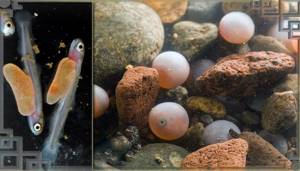
After 1-2 months, juvenile chum salmon reaches a length of 4-6 cm and goes to the sea to feed. By this time, the fry has scales, the body expands and takes on the forms familiar to the species, and the body is reconstructed for life in salt water.
Amateur fishing methods
Recreational fishing most often occurs in freshwater rivers, when chum salmon go to spawning grounds. Fishermen living near the mouth of rivers occupy a more advantageous position. Fish also has red and healthy meat. Anglers use two methods to catch migratory salmon. 1. Chum salmon bite well on artificial flies. To do this, you need to master the basics of fly fishing. Large concentrations of fish are observed below the rapids, where there are quiet areas of water. This is where you should cast bait. 2. Fans of spinning successfully catch migratory salmon using various lures. An important requirement for the bait will be stable operation in the current. Heavy spoons and spinners with a narrow, medium-sized blade work best. To cast the rig far, the spoon should weigh 10-20 g.
Gear and bait used
Having figured out what kind of fish chum salmon is, you can start assembling an amateur fishing rod. In the case of surface fishing with artificial flies, you will have to arm yourself with fly fishing tackle, and to use spinners you will need a spinning rod. • To assemble a fly fishing rod, you will need a 9-10 class rod. The inertial reel drum must accommodate at least 100 m of cord.
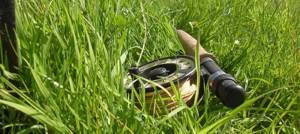
Attention! After hooking, chum salmon is capable of a long swim downstream at a distance of 40-60 m. • A leash is attached to the cord, which must have a breaking force of at least 7 kg. • To cast light flies at a distance of 15-20 m, anglers equip the fishing line with an additional sinker. • The best baits for catching chum are considered to be such types of flies as “Comet”, “Salmon Caviar” or “Boss”. It has been observed that fish grab wet flies immediately after splashdown. But dry models can be completely ignored. Spinning fishing can also be successful if you assemble the fishing rod correctly. • The spinning rod should be equipped with a durable plug-in or telescopic rod with a length of 2.7-3.0 m. • The fishing rod is equipped with a 3000-4000 spinning reel, which has an adjustable friction brake. • 100-120 m of monofilament with a thickness of 0.35-0.40 mm or braid with a similar breaking force is wound onto the spool. • Installation of the bait is carried out through a swivel with a carabiner. • For targeted fishing of chum salmon, Far Eastern fishermen use specialized spoons. One of them is the “RB Sakhalin-Keta” vibrator. It can be used for trolling or plumb fishing from a boat. Fishing from the shore can be successful when using Spinnex Keta spinners, Mepps spinners, Blue Fox, Myran size No. 3. Chum salmon in the Far East is also popular among fishermen, like pink salmon. Residents of adjacent settlements eagerly await the entry of large schools of salmon into the rivers. This is the best time for serious fishing.
Read expert opinions
About the features of fishing described in the article
chum salmon
About the features of the types of fishing described in the article
spinning
fly fishing
